
Murad I was the Ottoman Sultan from 1362 to 1389. He was a son of Orhan Gazi and Nilüfer Hatun. Murad I came into the throne after his elder brother Süleyman Pasha's death.

Medieval warfare is the European warfare of the Middle Ages. Technological, cultural, and social developments had forced a severe transformation in the character of warfare from antiquity, changing military tactics and the role of cavalry and artillery. In terms of fortification, the Middle Ages saw the emergence of the castle in Europe, which then spread to the Holy Land.

The Battle of Kosovo took place on 15 June 1389 between an army led by the Serbian Prince Lazar Hrebeljanović and an invading army of the Ottoman Empire under the command of Sultan Murad Hüdavendigâr. The battle was fought on the Kosovo field in the territory ruled by Serbian nobleman Vuk Branković, in what is today Kosovo, about 5 kilometers (3.1 mi) northwest of the modern city of Pristina. The army under Prince Lazar consisted of his own troops, a contingent led by Branković, and a contingent sent from Bosnia by King Tvrtko I, commanded by Vlatko Vuković. Prince Lazar was the ruler of Moravian Serbia and the most powerful among the Serbian regional lords of the time, while Branković ruled the District of Branković and other areas, recognizing Lazar as his overlord.

Miloš Obilić was a legendary Serbian knight who is reputed to have been in the service of Prince Lazar during the Ottoman invasion of Serbia in the late 14th century. He is not mentioned in contemporary sources, but features prominently in later accounts of the 1389 Battle of Kosovo as the assassin of Sultan Murad. Although the assassin remains anonymous in sources until the late 15th century, the dissemination of the story of Murad's assassination in Florentine, Serbian, Ottoman and Greek sources suggests that versions of it circulated widely across the Balkans within half a century of the event.

Jousting is a martial game or hastilude between two horseriders wielding lances with blunted tips, often as part of a tournament. The primary aim was to replicate a clash of heavy cavalry, with each participant trying hard to strike the opponent while riding towards him at high speed, breaking the lance on the opponent's shield or jousting armour if possible, or unhorsing him. The joust became an iconic characteristic of the knight in Romantic medievalism. The participants experience close to three and a quarter times their body weight in G-forces when the lances collide with their armour.
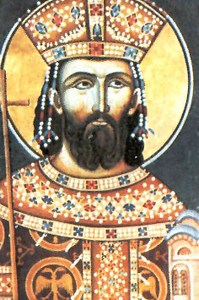
Prince Lazar Hrebeljanović was a medieval Serbian ruler who created the largest and most powerful state on the territory of the disintegrated Serbian Empire. Lazar's state, referred to by historians as Moravian Serbia, comprised the basins of the Great Morava, West Morava, and South Morava rivers. Lazar ruled Moravian Serbia from 1373 until his death in 1389. He sought to resurrect the Serbian Empire and place himself at its helm, claiming to be the direct successor of the Nemanjić dynasty, which went extinct in 1371 after ruling over Serbia for two centuries. Lazar's programme had the full support of the Serbian Orthodox Church, but the Serbian nobility did not recognize him as their supreme ruler. He is often referred to as Tsar Lazar Hrebeljanović ; however, he only held the title of prince.

A tournament, or tourney, was a chivalrous competition or mock fight in the Middle Ages and Renaissance. It is one type of hastilude. The shows were held often because of coronations, the marriage of kings, births, baptisms, weddings of princesses, conquests, peace, alliances, welcoming ambassadors or people of great worth, and even other minor events, experienced by the nobility. Over time the ecclesiastical festivities were also solemnized with them, of which there is a very marked testimony in the chronicle of Don Pero Niño: When he ordered to perform very honorable parties and processions, he ordered to perform jousts and tournaments and games of reeds and gave weapons and horses and rich clothes and garrisons to those who were to make these things.
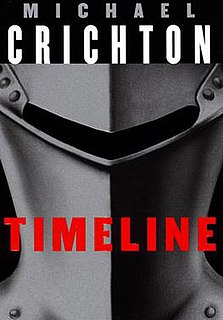
Timeline is a science fiction novel by American writer Michael Crichton, his twelfth under his own name and twenty-second overall, published in November 1999. It tells the story of a group of history students who travel to 14th-century France to rescue their professor. The book follows in Crichton's long history of combining science, technical details, and action in his books, this time addressing quantum and multiverse theory.
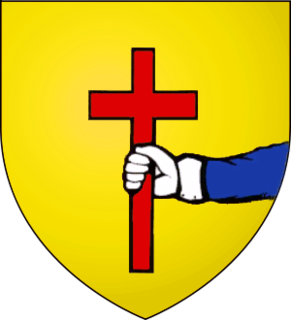
The O'Donnell dynasty were the dominant Irish clan of the kingdom of Tyrconnell, Ulster, in medieval and early-modern Ireland.
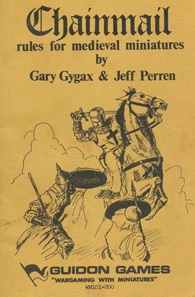
Chainmail is a medieval miniature wargame created by Gary Gygax and Jeff Perren. Gygax developed the core medieval system of the game by expanding on rules authored by his fellow Lake Geneva Tactical Studies Association (LGTSA) member Perren, a hobby-shop owner with whom he had become friendly. Guidon Games released the first edition of Chainmail in 1971 as its first miniature wargame and one of its three debut products.

The Visoki Dečani Monastery is a medieval Serbian Orthodox Christian monastery located near Deçan, Kosovo. It was founded in the first half of the 14th century by Stefan Dečanski, King of Serbia.

The destrier is the best-known war horse of the medieval era. It carried knights in battles, tournaments, and jousts. It was described by contemporary sources as the Great Horse, due to its significance.
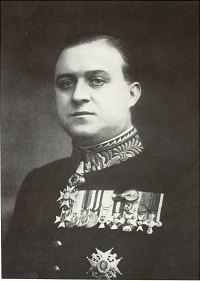
Sir Guy Francis Laking, 2nd Baronet was an English art historian and the first keeper of the London Museum from before its opening until his death.
Stephen Richard Turnbull is a British historian concentrating on Japanese military history, especially the samurai period, and has published numerous books. He provides information and advice to media organizations about Japan.

The Palace Armoury is an arms collection housed at the Grandmaster's Palace in Valletta, Malta. It was the main armoury of the Order of St. John in the 17th and 18th centuries, and as such it was the last arsenal established by a crusader military order. Although today only a part of the original armoury still survives, it is still one of the world's largest collections of arms and armour still housed in its original building. The Palace Armoury has been open to the public as a museum since 1860.
Christopher Gravett is an assistant curator of armour at the Tower Armouries specialising in the arms and armour of the medieval world.
Brian R. Price is an American university professor, author, editor, publisher, martial arts instructor of the Italian school of swordsmanship, reconstructive armorer, and member of the Society for Creative Anachronism. He is Associate Professor of History at Hawai'i Pacific University, where he offers courses in the history of warfare, in counterinsurgency, and in strategy at the graduate and undergraduate levels. He speaks regularly at conferences both for his current field on counterinsurgency and in his earlier, and now secondary field, on chivalric topics. His page at https://hpu.academia.edu/BrianRPrice lists his current and recent research projects. He began his studies of medieval history in 1990, but began to shift his interests as the Afghan and Iraq wars progressed, increasingly emphasizing aspects of modern military theory, especially ways through which culture, doctrine and military practice interweave. These modern topics have been a prominent part of his work since his graduation from the University of North Texas and deployment to Afghanistan as part of the Human Terrain System in 2011-2012. He has spoken at the UK Ministry of Defence, at the Society for Military History, the World History Conference, several academic martial arts symposia, and appeared on television to discuss the situation in Ukraine.

Danilo III was the fifth Patriarch of the Serbian Orthodox Church (1390–1396), a writer and poet, known also for transferring the relics of Lazar of Serbia from the church of Sveti Spas in Priština to Ravanica in 1391.
Tobias Emanuel ("Toby") Capwell FSA is an American historian who lives and works in London. His principal interest is in European arms and armour of the medieval and Renaissance periods. He is Curator of Arms and Armour at the Wallace Collection in London. He has written and spoken extensively on both the historical and the practical aspects of his subject. He is a skilled jouster, and has claimed to be the world's only jousting curator.
Elizabeth Ashman Rowe is an American historian and author who specializes in the study of the history and culture of the Viking Age.














